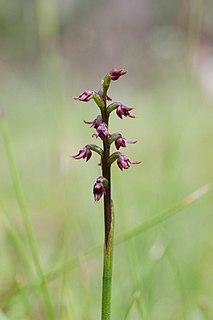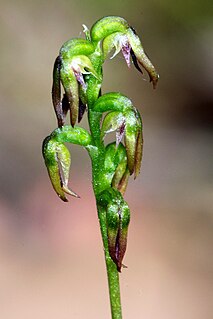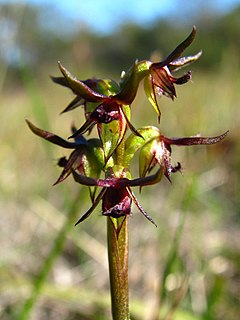
Genoplesium nudum, commonly known as the tiny midge orchid in Australia or the red midge orchid in New Zealand, is a small terrestrial orchid native to south-eastern Australia and New Zealand. It has a single thin leaf fused to the flowering stem and up to forty small, reddish-purple or green and red flowers. Australian and New Zealand authorities use the name Corunastylis nuda but Genoplesium nudum and Prasophyllum transversum are used by the World Checklist of Selected Plant Families.
Genoplesium rufum, commonly known as the rufous midge-orchid, is a species of orchid endemic to New South Wales. It has a single thin, wiry leaf and up to twenty five drooping, pinkish or reddish flowers on a flowering stem which is fused to the lower part of the leaf. It was formerly thought to range from Queensland to South Australia and Tasmania but specimens in other states are now assigned to Genoplesium clivicola.
Genoplesium nudiscapum, commonly known as the bare midge orchid, is a small terrestrial orchid endemic to Tasmania. It has a single thin leaf fused to the flowering stem and up to twenty small, green and reddish-brown flowers. It was thought to be extinct, since it had not been seen since 1852 but was rediscovered in 2008. The species has also been described as occurring on continental Australia. Australian authorities use the name Corunastylis nudiscapa for the Tasmanian endemic but Genoplesium nudiscapum is used by the World Checklist of Selected Plant Families.

Genoplesium despectans, commonly known as the sharp midge orchid and known as Corunastylis despectans in Australia, is a small terrestrial orchid endemic to south-eastern Australia. It has a single thin leaf fused to the flowering stem and up to forty five small, dark purple or green and purple flowers.

Genoplesium morrisii, commonly known as the bearded midge orchid and known as Corunastylis morrisii in Australia, is a small terrestrial orchid endemic to south-eastern Australia. It has a single thin leaf fused to the flowering stem and up to fifteen small, dark purplish-black or green and purple flowers.
Genoplesium acuminatum, commonly known as the pointed midge orchid and as Corunastylis acuminata in Australia, is a small terrestrial orchid endemic to eastern Australia. It has a single thin leaf fused to the flowering stem and up to sixteen small, hairy, greenish purple to brownish purple flowers. It is found in coastal and near-coastal parts of New South Wales and Queensland.

Genoplesium archeri, commonly known as the elfin midge orchid and as Corunastylis archeri in Australia, is a small terrestrial orchid endemic to south-eastern Australia. It has a single thin leaf fused to the flowering stem and up to fifteen small, hairy, yellowish green flowers with purple stripes. It grows in a wide range of habitats in New South Wales, Victoria and Tasmania.
Genoplesium littorale, commonly known as the Tuncurry midge orchid, and as Corunastylis littoralis in Australia, is a small terrestrial orchid endemic to New South Wales. It has a single thin leaf fused to the flowering stem and up to thirty small green flowers with a purple-brown labellum. It is only known from fewer than two thousand plants in a small area on the New South Wales North Coast and is critically endangered.

Genoplesium apostasioides, commonly known as the freak midge orchid, is a small terrestrial orchid endemic to New South Wales. It has a single thin leaf fused to the flowering stem and up to fifteen small, yellowish green flowers with a reddish labellum. The flowers do not open widely and are self-pollinating. It grows in heath and shallow moss gardens on rock ledges from the Blue Mountains to Nerriga.
Genoplesium bishopii, commonly known as the Gibraltar Range midge orchid and as Corunastylis bishopii in Australia, is a small terrestrial orchid endemic to New South Wales. It has a single thin leaf fused to the flowering stem and up to thirty small, dark purplish red flowers. It grows in heathy forest and on the edges of swamps in the Gibraltar Range National Park.
Genoplesium brachystachyum, commonly known as the Rocky Cape midge orchid or short-spike midge orchid and as Corunastylis brachystachya in Australia, is a small terrestrial orchid endemic to Tasmania. It has a single thin leaf fused to the flowering stem and up to twelve small, green to brownish green, and reddish flowers. It usually grows in heath in rocky places near the coast.
Genoplesium eriochilum, commonly known as the Mount Wilson midge orchid and as Corunastylis eriochila in Australia, is a small terrestrial orchid endemic to the Blue Mountains. It has a single thin leaf fused to the flowering stem and up to twenty small, crowded, dark purplish brown flowers. It usually grows between low shrubs and sedges.

Genoplesium pumilum, commonly known as the green midge orchid in Australia, and the yellow gumland leek orchid in New Zealand is a small terrestrial orchid native to south-eastern Australia and New Zealand. It has a single thin leaf fused to the flowering stem and up to twenty five green to yellowish-green flowers which sometimes have red markings. Australian and New Zealand authorities use the name Corunastylis pumila.
Genoplesium ruppii, commonly known as Rupp's midge orchid and as Corunastylis ruppii in Australia, is a small terrestrial orchid endemic to eastern Australia. It has a single thin leaf fused to the flowering stem and up to twenty five small, hairy green flowers with a purple labellum.
Genoplesium sagittiferum, commonly known as the horned midge orchid and as Corunastylis sagittifera in Australia, is a small terrestrial orchid endemic to New South Wales. It has a single thin leaf fused to the flowering stem and up to ten small, yellowish-green flowers with a hairy reddish labellum.
Genoplesium sigmoideum, commonly known as the Dave's Creek midge orchid, is a small terrestrial orchid endemic to a small area in the Lamington National Park in Queensland. It has a single thin leaf fused to the flowering stem and up to twenty dark red flowers with a hairy labellum.
Genoplesium tectum, commonly known as the Cardwell midge orchid, is a small terrestrial orchid endemic to a small area in north-eastern Queensland. It has a single thin leaf fused to the flowering stem and up to thirty light red flowers with a dark reddish-black, hairy labellum.
Corunastylis densa, commonly known as the dense midge orchid, is a small terrestrial orchid endemic to eastern Australia. It has a single thin leaf fused to the flowering stem and up to twenty five densely crowded reddish-brown to dark purplish-brown flowers. It is found between the New England National Park and the Moroka River.
Corunastylis laminata, commonly known as the red midge orchid, is a small terrestrial orchid endemic to New South Wales. It has a single thin leaf fused to the flowering stem and up to twenty bright reddish flowers. It grows in heath and grassy forest in a few places on the South Coast and Central Tablelands.
Corunastylis trifida, commonly known as the blackish midge orchid, is a small terrestrial orchid endemic to New South Wales. It has a single thin leaf fused to the flowering stem and up to twenty five dark purplish-black and green flowers. It grows in heath in scattered places in the Sydney basin.






